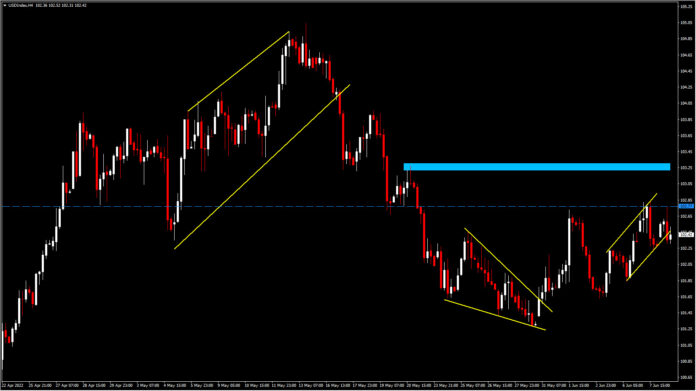The USDIndex has slumped, trimming earlier gains, but is holding the 102.00 handle. The index has dropped to 102.32, from a peak of 102.776 in European action. The buck is easing against the EUR with the pair at 1.0741 from 1.0671, after the upward revision to Q1 GDP and as the ECB meeting looms. And it is at the lower end of the day’s range against the Pound with GBPUSD at 1.2529 from 1.2598.
The US Dollar has climbed solidly against JPY, with USDJPY rising to 134.37, back to a 20-year peak. The dovish BoJ stance was affirmed overnight as Governor Kuroda emphasized the need for accommodative policy, while noting a weaker Yen is not desirable, though we note it is hard to have one without the other. Kuroda noted the criticism but added FX is the purview of the MOF and the government.
The Dollar slumped, along with stocks and bonds in the red, as stagflation fears picked up again today due to the OECD world growth forecasts after the bearish World Bank report yesterday, and the also the plunge in MBA mortgage applications.
OECD cuts its world growth forecast and warned that the world economy will pay a “hefty price” for Russia’s invasion of Ukraine. The OECD cut its projection for global GDP to 3% from 4.5% previously. At the same time the inflation forecast was doubled to 8.5% – the highest level since 1988. The OECD said that before the war broke out, the outlook for 2022-2023 had looked “broadly favourable”, as economies were set to return to normal after the pandemic. However, the Ukraine war has changed the picture dramatically, with the OECD highlighting that the “invasion of Ukraine, along with shutdowns in major cities and ports in China due to the zero-Covid policy, has generated a new set of adverse shocks”. The growth forecast for the US was scaled back to 2.5% from 3.7%, and that of China to 4.4% from 5.1%. Eurozone GDP growth is now expected to be at 2.6% instead of 4.3% and the UK’s forecast was lowered to 3.6% from 4.7%. The report also flagged that the rise in commodity prices is hitting real income and spending “particularly for the most vulnerable households”. At the same time “in many emerging market economies the risks of food shortages are high given the reliance on agricultural exports from Russia and Ukraine”.
Meanwhile, the US mortgage rate climb continues to sharply depress the MBA refi measure, though mortgage rates have stabilized somewhat over the past four weeks, and we have marked down our housing estimates into Q3 based on weakness in the purchase index. The MBA purchase index entered June -10.1% below the May average, after declines of -7.0% in May to a 2-year low and -6.9% in April to a prior low. We saw a 1-year high in January of 2022 that fell short of the 12-year high in January of 2021. A -50% contraction rate is expected for the purchase index in Q2 that would extend the -12.8% Q1 pull-back, after a 40.2% climb in Q4. The purchase index should fall -13% in 2022, which would mark the largest decline since the same -13% drop in 2014. The refi index entered June -13.3% below the May average, after a 9th consecutive drop in May, of -18.5%, and a -36.4% plunge in April. The index is falling at a -96% rate in Q2, and is poised for a -69% contraction in 2022 that exceeds the -52% “taper tantrum” drop in 2014.
Click here to access our Economic Calendar
Andria Pichidi
Market Analyst
Disclaimer: This material is provided as a general marketing communication for information purposes only and does not constitute an independent investment research. Nothing in this communication contains, or should be considered as containing, an investment advice or an investment recommendation or a solicitation for the purpose of buying or selling of any financial instrument. All information provided is gathered from reputable sources and any information containing an indication of past performance is not a guarantee or reliable indicator of future performance. Users acknowledge that any investment in Leveraged Products is characterized by a certain degree of uncertainty and that any investment of this nature involves a high level of risk for which the users are solely responsible and liable. We assume no liability for any loss arising from any investment made based on the information provided in this communication. This communication must not be reproduced or further distributed without our prior written permission.




















